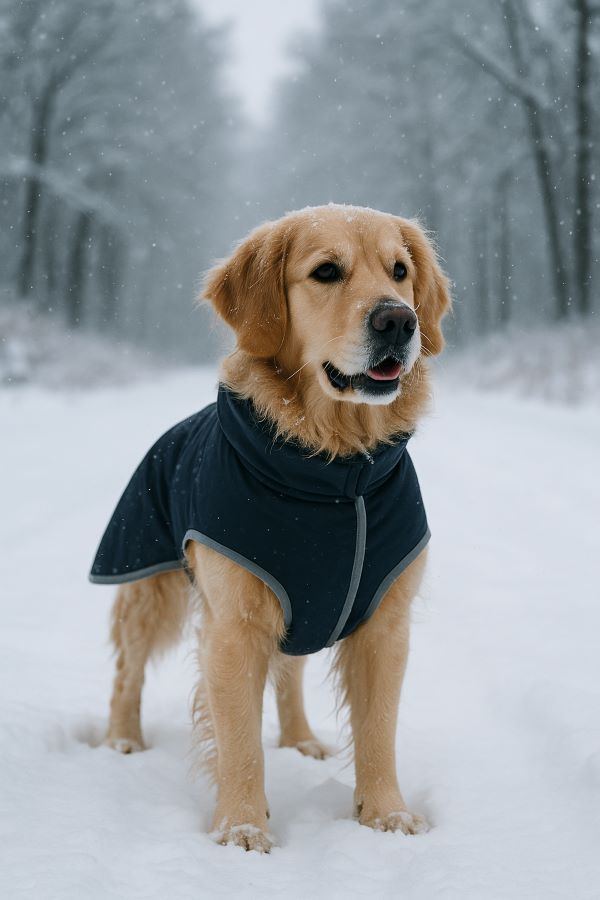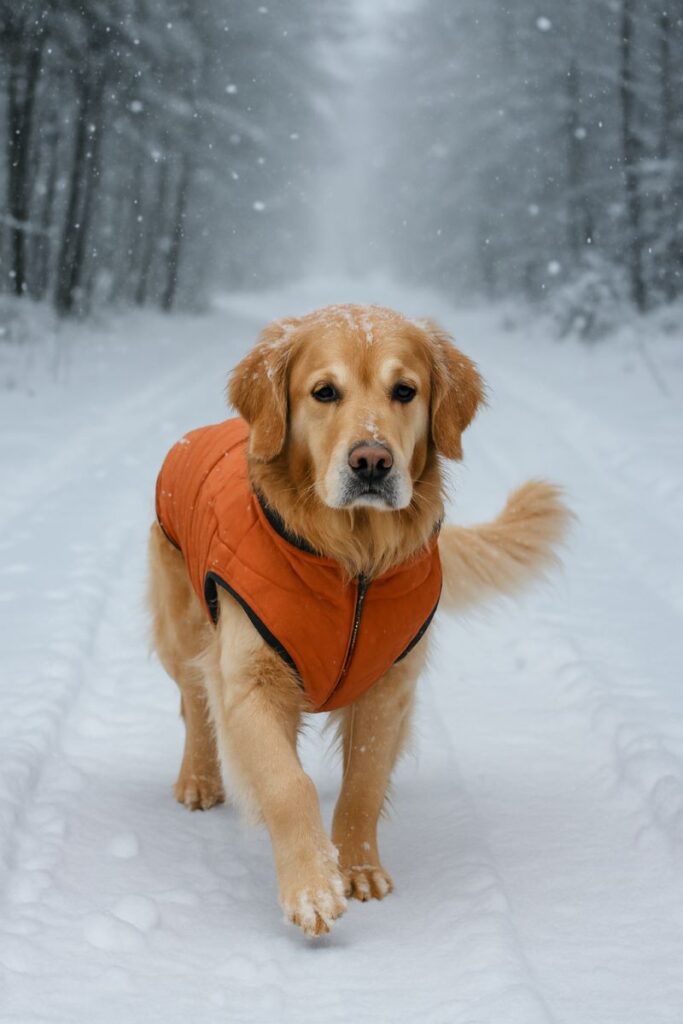
How Cold Is Too Cold to Walk Your Dog? What Owners Need to Know Before Winter Hits
Sudden winter drops catch dog owners out every year. Vets consistently report spikes in hypothermia cases as temperatures fall, and search interest for “is it too cold to walk my dog?” surges across the UK when cold snaps hit.
This guide gives clear, evidence-based thresholds, based on veterinary guidance including the Tufts Animal Condition and Care scale, so you know exactly when it is safe to walk your dog in winter – and when it is not.
What’s a safe temperature for walking your dog in winter?
Veterinary bodies broadly agree on the following temperature ranges:
- Above 7°C – Safe for most dogs
- 0°C to 7°C – Caution zone for small, elderly and thin-coated breeds
- –1°C to –6°C – Elevated risk; shorten walks and use coats
- –7°C to –12°C – Dangerous for many breeds; frostbite and hypothermia risks
- Below –12°C – Unsafe; toilet breaks only
These thresholds assume dry weather. Wind, snow and wet fur all reduce real-world tolerance significantly, even when the number on your weather app looks borderline safe. If you are wondering “how cold is too cold to walk my dog?”, anything at or below freezing needs extra caution.
Temperature Risk Chart: Safe Winter Temperatures for Dog Walking

your safe winter temperatures chart
Use this visual as a quick reference before heading out.
Signs your dog is too cold
Your dog’s behaviour is the best early-warning system. Cut the walk short immediately if you notice:
- Shivering or trembling
- Slowing down or refusing to walk
- Repeated paw lifting
- Tail tucked tightly under the body
- Whining, anxiety or trying to turn back
- Ice or snow compacted between paw pads
These are classic early signs of cold stress and, if ignored, can progress towards hypothermia.
Breed differences: who tolerates winter best?
Cold tolerance varies dramatically between breeds.
More cold-tolerant breeds:
Huskies, Malamutes, Akitas, Newfoundlands, Bernese Mountain Dogs and other double-coated working or mountain breeds. These dogs are physically built for snow and sub-zero temperatures.
More cold-sensitive breeds:
Whippets, Greyhounds, Chihuahuas, Dachshunds, French Bulldogs, Boxers, Staffies and most toy breeds. Short coats, smaller frames and lower body fat mean they lose heat far more quickly.
Even within the same breed, age and health make a difference. A fit, adult Husky can cope with cold weather that would be unsafe for an elderly French Bulldog.
If you enjoy seeing how different breeds look in clothing and costume, you can explore examples of our Dogs in Uniform Paintings here.

How long should you walk your dog in winter?
Use these time guidelines as a starting point:
- Above 5°C: Normal walk duration for most healthy dogs
- 0°C to 5°C: 20–40 minutes depending on breed, age and coat type
- –1°C to –6°C: 10–20 minutes maximum, even for hardy breeds
- Below –7°C: Toilet breaks only, then back indoors
Adjust for your dog’s age, fitness and behaviour. If your dog is slowing down, shivering or trying to head home, do not push for “just a few more minutes” because that is your usual routine.
When to skip the walk entirely
There are days when it is simply too cold to walk your dog, even with a coat. Avoid or drastically shorten walks if:
- Your dog is already shivering before you leave the house
- Pavements and roads are icy and slippery
- Wind chill makes the air feel much colder than the stated temperature
- Your dog has arthritis, heart disease, respiratory issues or is recovering from illness
- Paw pads are cracked, bleeding or clearly painful
On these days, replace outdoor walks with indoor exercise and enrichment. Ideas include food puzzle toys, scent games, short training sessions, hide-and-seek with treats or practising recall and tricks down a hallway.
Winter dog-walking essentials
The right gear makes winter dog walking much safer:
- Insulated dog coat – essential for short-haired, small and elderly dogs
- Paw balm or winter booties – protect pads from ice, grit and salt
- LED collar or clip-on light – improves visibility in dark winter evenings
- Reflective harness or jacket – helps drivers see your dog
- Drying towel – to dry your dog off as soon as you get home
- Snout and pad balm – for very cold or windy conditions
If you regularly walk in snow or on gritted pavements, get into the habit of rinsing and checking your dog’s paws after every walk.
Cold weather dog safety: quick reference
If you want a simple mental checklist before every winter walk, use this:
- Check the actual temperature and “feels like” (wind chill) value.
- Look at your dog’s breed, coat and age. Small, short-haired or elderly = shorter walks.
- Decide on a rough time limit based on the ranges above.
- Watch behaviour during the walk – shivering, slowing down or lifting paws means it is time to go home.
- Dry your dog off and warm up indoors afterwards.
Following this routine covers most realistic cold-weather scenarios for pet dogs.
Factors to Consider When Walking Dogs in Cold Weather
Knowing the right temperature for walking your dog is key to keeping them safe. While there’s no universal answer, several factors influence a dog’s tolerance to cold:
Wind Chill
Wind chill affects how cold it feels outside, often lowering the perceived temperature significantly. Even mild winds can make it feel much colder. Check reliable weather apps, like the Met Office, for the “real-feel” temperature before heading out, especially if your dog is less tolerant to cold.
Dog’s Coat Type
A dog’s coat plays a major role in how well they handle the cold. Breeds like Huskies and Newfoundlands with thick, insulating fur are naturally equipped for colder climates. Conversely, thin-coated breeds such as Greyhounds or Whippets feel the cold more and benefit from a warm winter jacket during outings.
Age and Health
Puppies, senior dogs, and those with existing health issues are more susceptible to cold weather. These dogs can become chilled quickly and are at greater risk of developing hypothermia. Always take extra precautions, such as limiting their time outside and dressing them appropriately.
Dog’s Size
Smaller dogs lose heat faster than larger breeds. Additionally, dogs with short legs, like Dachshunds and Basset Hounds, are closer to the cold ground and can feel the chill more intensely. Consider protective clothing and limit their exposure to freezing temperatures.
What Temperature Is Too Cold for a Dog in a House?
Indoor temperatures below 10°C can feel uncomfortably cold for dogs, especially smaller breeds or those with thin coats. Dogs are most comfortable in a home environment that is between 18°C and 22°C, which mirrors the typical indoor temperature for humans.
Factors Affecting a Dog’s Comfort Indoors:
- Breed and Coat Type: Thick-coated breeds like Huskies and Malamutes can tolerate cooler indoor conditions better than short-haired breeds like Chihuahuas or Whippets.
- Age and Health: Puppies, senior dogs, and those with chronic health conditions are less able to regulate their body temperature and may need extra warmth.
- Sleeping Arrangements: Providing a warm, insulated bed away from drafts can make a big difference. Consider heated dog beds or extra blankets in colder months.
If your house feels chilly to you, it’s likely too cold for your dog as well. Ensure your pet has a warm, comfortable space to rest, particularly during the winter.
FAQs: Winter Dog Walking
How cold is too cold for most dogs?
Below 0°C requires caution for most dogs. Below –7°C is unsafe for many breeds, especially small, elderly or short-coated dogs, and walks should be kept to quick toilet breaks only.
Can dogs get hypothermia?
Yes. Dogs can develop hypothermia in cold and wet conditions, particularly in sub-zero temperatures or when exposed for too long. Symptoms include shivering, stiffness, lethargy, confusion and very cold ears or paws. Hypothermia is a veterinary emergency.
Is it safe to walk dogs in snow?
Short walks in snow can be safe if your dog is otherwise healthy, well protected and you watch for signs of discomfort. Take extra care with ice, remove compacted snow from between paw pads and avoid areas treated with harsh de-icing chemicals.
Do dogs need coats in winter?
Most small, elderly and short-haired dogs benefit from a winter coat, especially in temperatures below 7°C. Double-coated breeds such as Huskies or Newfoundlands may not need a coat except in extreme cold or if they are very young, old or have underlying health conditions.
What temperature is too cold for puppies?
Puppies struggle with cold much more than adult dogs. Below 5°C is challenging, and below freezing is unsafe for anything longer than a brief toilet break. Keep outdoor time short and focus on indoor play and training when it is very cold.
Commission a Custom Winter Dog Portrait
If winter is part of your dog’s story – the snowy walks, the frosty whiskers, the ridiculous little coat you pretend you bought “just for practicality” – you can turn those memories into a hand-painted portrait from Dog Artists.
Our portraits are painted in premium oils on canvas and tailored to your dog’s individual character, whether you imagine them as a regal figure in a Renaissance Pet Portrait or suited up in full military attire from our Dogs in Uniform collection.
Explore our Renaissance collection:
https://www.dogartists.co.uk/renaissance-pet-portraits/
See more examples of dogs painted in uniform and in costume
For more dog-care articles and inspiration, visit the Dog Artists blog
Be sure to check out our other dog blog articles for more creative inspiration and insights:






